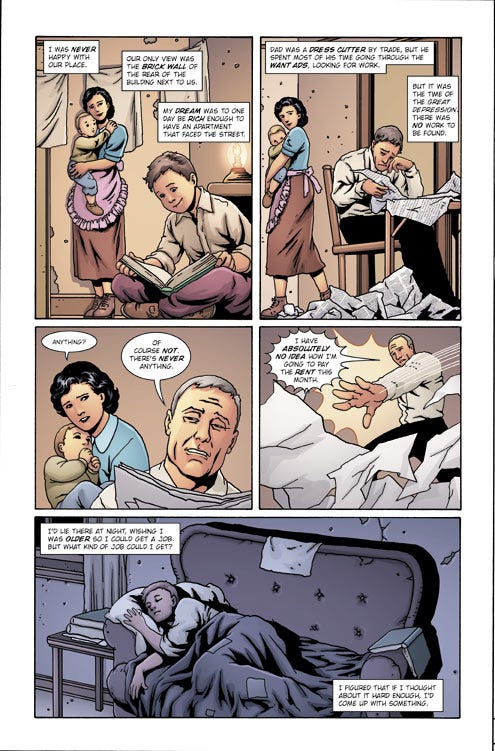Why I draw Pages Out of Order
Labor Cost, Contemplation, Complexity.
I’m often asked why I don't just sit down and draw each comic page in order from start to finish as many other creators are said to do. I’m sure editors would prefer it, and I know it drives some editors crazy when artists work out of order. Editors who understand what I’m doing are much appreciated and understand my process.
So here goes.
I sit down and do a number of thumbnails or layouts, maybe for the the entire book, maybe not. I used to work cold directly on the page, going straight from script to final. I haven’t done that in years, but there it is for your info. Since I am almost always doing graphic novels now, I find working from thumbs is safer.
Thumbnail. Good Omens Page 1.
Pencils. The greyish areas under those pencils are from blowing up the thumbnails and blocking out areas digitally, then placing this under the final drawing paper so I could sketch right on top. I almost always do this now. If you look closely, the prelim doesn’t really line up. It’s not supposed to, it’s just a placement guide.
When I have finished those thumbs/layouts, I have had time to get away from the earlier page designs. After days or weeks, I can look at them with a fresh eye and see new ideas or mistakes I did not see before. If I sit down and do one page at a go, I do not have the advantage of distance and reflection.
When working on a monthly comic, you don’t get a lot of time for distance or reflection, the deadline is always on your back.
Drawing one character at a time over a large swatch of pages keeps character and costume design consistent. This is especially important when you are juggling a large cast with many costume changes.
My costumes and sets can be complex and varying, so this is a major consideration.
Original art from A Distant Soil. Lettering by me is by hand as well.
If I am working on a monthly comic of only 22 pages, and sets like The Daily Bugle are already well-established, this is not such a big deal. But when working on a 140 page graphic novel like Gone to Amerikay, I not only have to do period research, but I have to accurately depict that period, and to create new sets every few pages.
Pull pages which have the same set designs and draw those pages as a group, and this task is made easier.
Yes, I drew all those bricks by hand.
Colors by Jose Villarubia.
Gone to Amerikay was set in the same location on the same, real New York street - Clinton ST - over a 150 year time period. That was a task.
Ink and correction fluid take time to dry. I ink large areas at one time. There's no reason to sit and wait for that to dry. Just move on to the next page and keep working.
Some pages are much harder to create and are far more time-consuming than others.
This double page spread from Chivalry which was painted by hand…
Took a lot longer than this double page spread from Gotham City Garage, which was drawn in pen and ink and colored (by me) digitally.
A major spread takes roughly a week to draw. That's only eight pages produced in one month. In order to keep production steady, I pull those double page spreads and move them to the front of the production line. Then I chip away at them, sometimes for months at a time. I draw an hour here or an hour there, while working on easier pages. Over the course of several months, there's no discernible drop in production, because I am producing easier pages steadily.
A book which is front loaded with establishing shot settings will get bogged down early.
Style and complexity make a huge difference. When people ask, “How long does it take to draw a page?” they assume the same labor cost on every page.
That’s not how this works.
Here are two pages, both set in a New York tenement, one in the 1860’s, one in the 1930’s. The above page from Gone to Amerikay, and the second page from Stan Lee’s memoir Amazing Fantastic Incredible Stan Lee.
This:
Takes longer than this:
If I have to pull pages 35-40 and work on easy pages while letting pages 4-10 sit so I can still move forward, I will.
It's demoralizing to see yourself slipping behind. Give yourself a break once in awhile and do an easy page to keep moving.
Sometimes I can easily figure out what to do on one part of a page, but may want to rethink another part. I set it aside and come back to it later while moving on to something else.
Detail work and certain types of rendering can be hard on the digits after a long day: I get sore. Switch over to some other task (such as spotting blacks) and come back to detail work later.
Sometimes I get bored, and move on to something new. If you push yourself to keep producing on a page toward which you have developed unenthusiastic hostility, you are unlikely to do a very good job on it. Set it aside and tackle it with a clear head.
OK, that's why I draw comic pages out of order.
Thanks for reading. Books can be ordered by clicking the links.










Thanks for the insight!
In many ways, your approach seems similar to making a movie —> few are filmed in chronological story order. Thanks for sharing your workflow and insights!